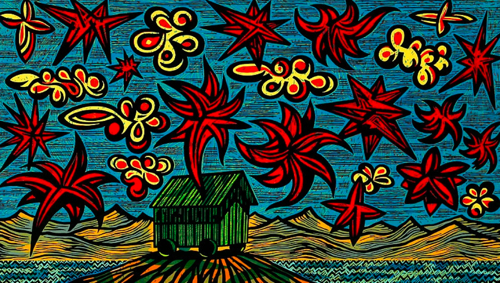Dominican Republic
by Woodblock
Impact
How much wood can a woodblock block if a woodblock could block wood?
Evidently a lot.
Woodblock -- the art of etching color into a bar of chocolate.

14 Stars & 10 Clouds
color woodblock print on Kozo Okawara washi by Bosnian-American Endi Poskovic
Evidently a lot.
Woodblock -- the art of etching color into a bar of chocolate.

Appearance 4.6 / 5
smart 25g bar; rectangular Kit Kat™ shape; perfect fit for the chest pocket (& wise move for Woodblock's market & wallet); depending on one's perspective, that means naturally no sharing
smart 25g bar; rectangular Kit Kat™ shape; perfect fit for the chest pocket (& wise move for Woodblock's market & wallet); depending on one's perspective, that means naturally no sharing
| Color: | polychromatic |
| Surface: | idealized |
| Temper: | flashback |
| Snap: | strong & deep throated |
Aroma 8.4 / 10
practically smokable: very green (tobacco leaf & picholine) -> wood (naturally) -> some stoneground element -> all in convergence of a tannic mole -> fumigates brown fruit (tamarind & bilberry)
Mouthfeel 12.9 / 15
| Texture: | slow going at the start, then releases effortlessly to... |
| Melt: | ... a numbing tingle (stringent streak) |
Flavor 45.3 / 50
springs up tamarind -> figs with a shot of chocolate beneath -> super sweet mango & black currant (exceptional) -> a passing licorice, then smoke signals for 'here come the tannin guns': tobacco & green tea -> stringency causes a little rum-toffee -> closes out on a guava -> caramel sweeps up in the after-length like a janitor
Quality 17.7 / 20
On the wrapper Woodblock claims "sourced, roasted, cracked, winnowed, conched & aged in Portland, OR".
Either global-warming must really be heating up, dramatically reaching the Pacific Northwest, in order to source cacao from there, or in all likelihood Woodblock procured these cocoa kernels from Oregon neighbor & Chocolate Alchemist, John Nanci. Specifically, the cultivar called La Red grown in of The Dominican Republic.
As per aging, that falls in line with a developing movement of Vintage Chocolate.
Whatever the exact circumstances, the endless accumulation of facts into chocolate's constituent parts -- a process leading to reductionism -- only renders limited understanding of the causes behind a great bar. Teasing apart & breaking down the process allows a snarl of interactions to be reduced into a list of bits & incremental steps that deceive us into hoping that the details of this dizzying intricacy, with components altering one another, will reveal how the relationships fit together into a predictable loop. Hell, this site often relies on such a futile approach.
A ceaseless pursuit really, for in truth the ultimate causes to this mysterious whirligig called 'chocolate' are never fully known but merely inferred. In fact, the more we know, the less we understand. Any who proclaim otherwise are masturbating in a vanity to stroke their own ego. A rather peculiar way to go about that business at hand.
Let it suffice that Woodblock selects exceedingly well, then processes with distinction. Particularly the manner in which it cuffs the polyphenols of this cocoa while enlivening the fruited acidity.
Shades of Rogue's early Hispaniola: less with respect to taste (they're quite different flavor-wise) & more in regards to rookies hitting home runs at their first-at-bats in the majors.
The common denominator, of course, is that D.R. covers for a lot of inexperience. Its cultivation & post-harvesting improvements, combined with favorable weather the last few crops, have vaulted the island into the 'it' destination for cacao.
Even so, whether dumb luck or just no-substitute-for-youth, both labels earn their accolades because some seasoned veterans have taken their swings at this same origin only to miss.
Pretty special.
ING: cocoa mass, sugar
Reviewed January 19, 2012
Either global-warming must really be heating up, dramatically reaching the Pacific Northwest, in order to source cacao from there, or in all likelihood Woodblock procured these cocoa kernels from Oregon neighbor & Chocolate Alchemist, John Nanci. Specifically, the cultivar called La Red grown in of The Dominican Republic.
As per aging, that falls in line with a developing movement of Vintage Chocolate.
Whatever the exact circumstances, the endless accumulation of facts into chocolate's constituent parts -- a process leading to reductionism -- only renders limited understanding of the causes behind a great bar. Teasing apart & breaking down the process allows a snarl of interactions to be reduced into a list of bits & incremental steps that deceive us into hoping that the details of this dizzying intricacy, with components altering one another, will reveal how the relationships fit together into a predictable loop. Hell, this site often relies on such a futile approach.
A ceaseless pursuit really, for in truth the ultimate causes to this mysterious whirligig called 'chocolate' are never fully known but merely inferred. In fact, the more we know, the less we understand. Any who proclaim otherwise are masturbating in a vanity to stroke their own ego. A rather peculiar way to go about that business at hand.
Let it suffice that Woodblock selects exceedingly well, then processes with distinction. Particularly the manner in which it cuffs the polyphenols of this cocoa while enlivening the fruited acidity.
Shades of Rogue's early Hispaniola: less with respect to taste (they're quite different flavor-wise) & more in regards to rookies hitting home runs at their first-at-bats in the majors.
The common denominator, of course, is that D.R. covers for a lot of inexperience. Its cultivation & post-harvesting improvements, combined with favorable weather the last few crops, have vaulted the island into the 'it' destination for cacao.
Even so, whether dumb luck or just no-substitute-for-youth, both labels earn their accolades because some seasoned veterans have taken their swings at this same origin only to miss.
Pretty special.
ING: cocoa mass, sugar
Reviewed January 19, 2012




